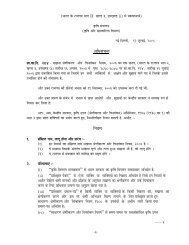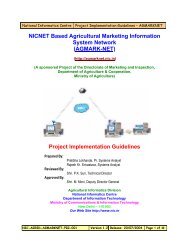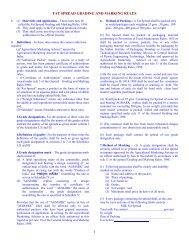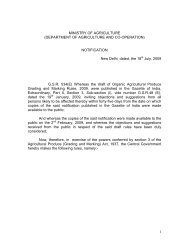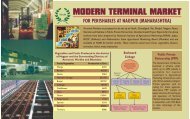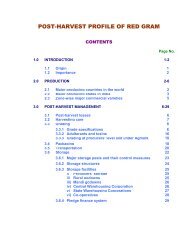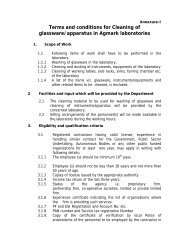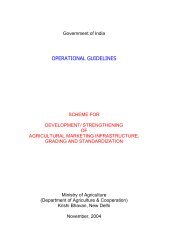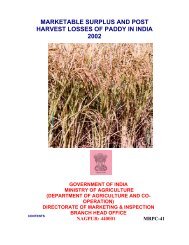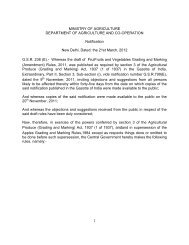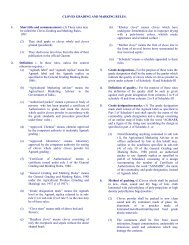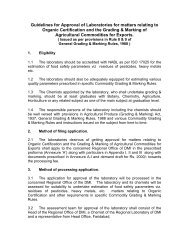Post Harvest Profile of Wheat - Agmarknet
Post Harvest Profile of Wheat - Agmarknet
Post Harvest Profile of Wheat - Agmarknet
Create successful ePaper yourself
Turn your PDF publications into a flip-book with our unique Google optimized e-Paper software.
B. Special Characteristics :<br />
Grade<br />
Special characteristics<br />
designation<br />
Foreign Other<br />
Maximum limits <strong>of</strong> tolerance 1% by weight<br />
Other Damaged Slightly Immature Weevilled<br />
Matter Food <strong>Wheat</strong>s Grains Damaged shriveled and grains<br />
Grains<br />
Grains broken grains<br />
I 1.5 1.6 5.0 1.0 2.0 2.0 1.0<br />
II 2.5 3.0 15.0 2.0 4.0 4.0 3.0<br />
III 3.5 6.0 20.0 4.0 6.0 10.0 6.0<br />
IV 4.0 8.0 20.0 5.0 10.0 10.0 10.0<br />
C. Definition :<br />
Foreign matter : It includes, dust, stones, lumps <strong>of</strong> earth, chaff, stem <strong>of</strong> straw and any<br />
other impurity including non-edible seeds.<br />
Other Food Grains : Edible foodgrains other than wheat.<br />
Other <strong>Wheat</strong>s : For this purpose wheat would be divided into two classes – (1) Durum<br />
or Macroni wheat and (2) Vulgare or common wheat; Durum again<br />
would be sub-divided into two groups (i) amber and (ii) red ; and<br />
Vulgare would be sub-divided in to three groups – (i) white (ii) amber<br />
and (iii) red.<br />
Damaged Grains : Grains that are internally damaged or discoloured, damage and<br />
discolouration materially affecting the quality.<br />
Slightly Damaged : Grains that are superficially damaged or discoloured, damage<br />
Grains and discolouration not materially affecting the quality.<br />
Immature, Shrivelled : Immature and shrivelled grains are those that are not properly<br />
& Broken Grains developed. Broken grains are pieces <strong>of</strong> whole grains.<br />
Weevilled Grains : Grains that are partially or wholly bored or eaten by weevil or other<br />
grain insects.<br />
N.B. – Grades I and II should be free from living insect infestation.<br />
III) Codex Standards :<br />
The Codex Alimentarius Commission was set up in the year 1963 by FAO and WHO to<br />
develop food standards, guidelines and related texts such as code <strong>of</strong> practice under the Joint<br />
FAO/WHO Food Standards Programme. The main purposes <strong>of</strong> this programme are to protect<br />
health <strong>of</strong> the consumer, ensure fair trade practices in the food trade, and promote coordination <strong>of</strong><br />
all food standards work undertaken by the international governmental and non-governmental<br />
organizations. The Commission has developed more than 200 standards in the prescribed<br />
format for individual or group <strong>of</strong> foods including the General Standards for labeling <strong>of</strong> pre-packed<br />
foods, the Codex Central guidelines on claims and the Codex Guidelines on Nutritional Labeling<br />
etc.<br />
12




